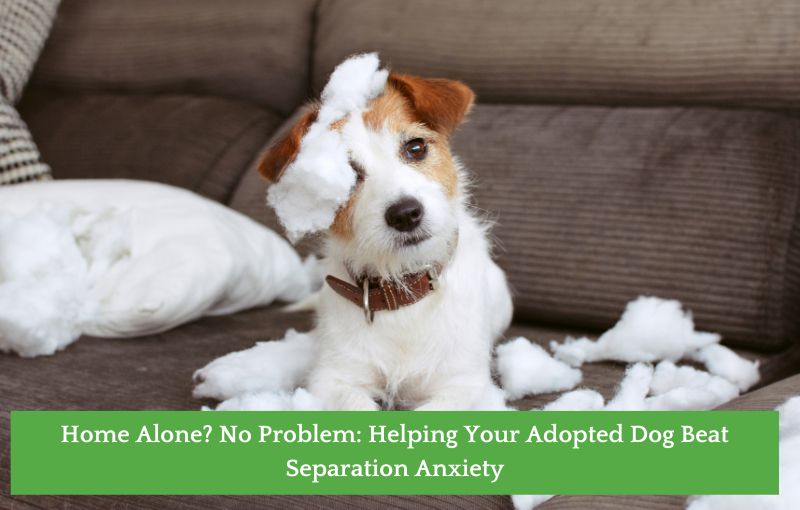
Separation anxiety is a common issue in adopted dogs, especially those with an uncertain past or history of abandonment. When a dog struggles with being left alone, it can result in stress-induced behaviours like excessive barking, destruction of household items, or even attempts to escape. Fortunately, with patience and the right strategies, you can help your dog feel more secure when you’re away.
Here’s how to recognise the signs of separation anxiety and manage it effectively to reduce stress for both you and your dog.
Signs of Separation Anxiety in Dogs
- Excessive Barking or Howling:
- Your dog may vocalise continuously when left alone, often sounding distressed rather than just playful barking.
- Destructive Behaviour:
- Chewing furniture, scratching doors or windows, and digging can indicate your dog is trying to relieve stress or escape to find you.
- Pacing or Restlessness:
- Some dogs walk back and forth in a specific pattern when they feel anxious or trapped.
- Attempts to Escape:
- Your dog might try to dig under fences, scratch at windows, or squeeze through openings to find you. This behaviour can be dangerous, resulting in injury.
- House Soiling:
- Even if house-trained, an anxious dog may urinate or defecate indoors as a response to stress.
- Following You Everywhere:
- Clinginess, where your dog refuses to leave your side, can indicate they are fearful of being left alone.
Techniques to Manage Separation Anxiety
1. Create a Predictable Routine
Dogs thrive on consistency. Establishing a daily routine for feeding, walks, and playtime can reduce anxiety by helping your dog feel more secure. If they know what to expect each day, it reduces uncertainty and builds confidence.
2. Practice Gradual Departures
Help your dog get used to being alone by practising short departures. Start by leaving them alone for just a few minutes and gradually increase the time. This technique, known as desensitisation, helps your dog learn that you’ll always return.
- Begin with stepping out of the room for a few minutes.
- Leave the house briefly and return without making a fuss.
- Gradually increase the time away to longer intervals.
3. Don’t Make Leaving or Returning a Big Deal
Avoid dramatic goodbyes and enthusiastic greetings, as this can heighten your dog’s anxiety. When you leave, be calm and matter-of-fact. Upon returning, wait until your dog is calm before giving them attention.
4. Provide Mental Stimulation
Toys and puzzles that engage your dog’s mind can help distract them while you’re away. Consider using:
- Food puzzles or treat-dispensing toys.
- Interactive toys like Kongs filled with peanut butter.
- Chew toys that keep them occupied for long periods.
Rotating toys can keep things fresh and interesting for your dog.
5. Exercise Before You Leave
A well-exercised dog is less likely to feel anxious. Take your dog for a walk or engage in active play before leaving the house. Physical activity helps burn off excess energy and encourages your dog to rest while you’re gone.
6. Use Calming Aids
There are various calming aids that can help reduce anxiety in dogs:
- Adaptil diffusers or sprays that release soothing pheromones.
- Calming jackets or wraps that apply gentle pressure to comfort your dog.
- Herbal supplements or vet-approved anxiety medication (if recommended by your vet).
7. Create a Safe Space
Some dogs feel more secure in a specific area of the house when left alone. This might be a crate (if they are crate-trained) or a quiet room with familiar bedding and toys. A safe space provides comfort and helps reduce anxiety.
8. Consider a Dog Walker or Pet Sitter
If your schedule allows, arranging for a dog walker or pet sitter to visit during the day can provide companionship and break up long periods of isolation.
When to Seek Professional Help
If your dog’s separation anxiety is severe or doesn’t improve with these strategies, it may be helpful to consult a professional trainer or a veterinary behaviourist. Severe anxiety might require a tailored behaviour modification plan or short-term medication to help your dog through the adjustment period.
Managing separation anxiety in adopted dogs takes time, consistency, and understanding. With patience, gradual departures, mental stimulation, and a calm approach, you can help your dog feel more secure when you’re not at home. Remember, every dog’s adjustment is unique, so be gentle with both yourself and your furry friend during this process. With love and the right support, your dog will learn that being alone isn’t as scary as it seems.Help your adopted dog overcome separation anxiety with our expert tips.

